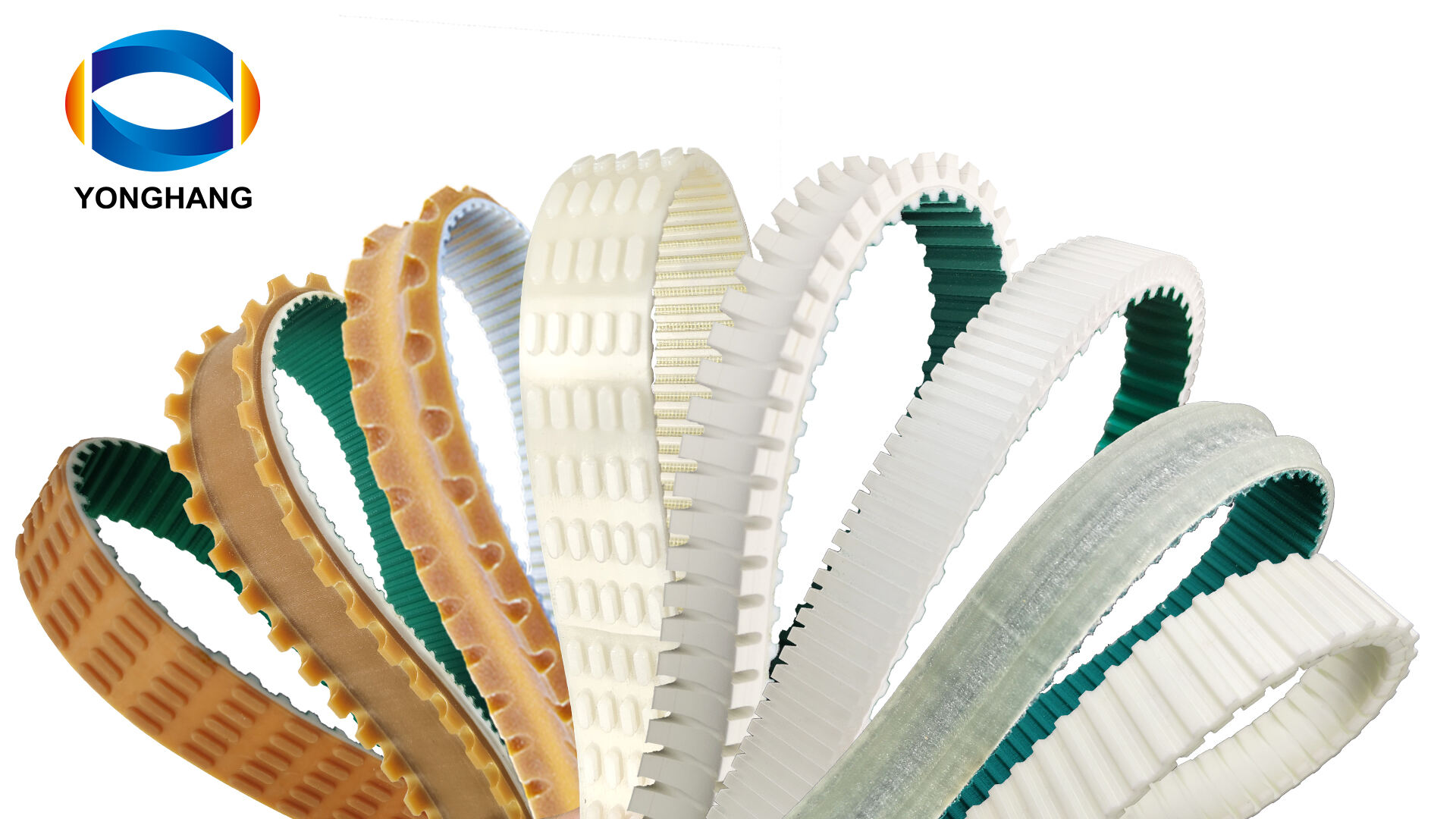Στη βιομηχανία παραγωγής τροφίμων, η διατήρηση της υγιεινής είναι πρωταρχικής σημασίας, ιδιαίτερα όταν πρόκειται για την επεξεργασία κρεατοσκευασμάτων, όπως οι κολοκυθιές.
Ιμάντες χρονισμού λουκάνικου παίζουν σημαντικό ρόλο στη διασφάλιση ότι οι γραμμές παραγωγής λειτουργούν ομαλά, τηρώντας παράλληλα αυστηρά πρότυπα υγιεινής. Το άρθρο αυτό εξετάζει τη σημασία αυτών των ιμάντων στην παραγωγή τροφίμων, τα μοναδικά τους χαρακτηριστικά και τα πλεονεκτήματα που προσφέρουν στους κατασκευαστές.
Η πρώτη πτυχή που πρέπει να ληφθεί υπόψη είναι το υλικό που χρησιμοποιείται στους ιμάντες χρονισμού κολοκυθιών.
Οι ιμάντες αυτοί κατασκευάζονται συνήθως από υλικά ποιότητας τροφίμων, ανθεκτικά στα βακτήρια και εύκολα στον καθαρισμό. Σε αντίθεση με τους συμβατικούς ιμάντες, οι οποίοι μπορούν να διατηρούν ρύπους, οι ιμάντες χρονισμού ποιότητας τροφίμων έχουν σχεδιαστεί ειδικά για περιβάλλοντα επεξεργασίας τροφίμων. Αυτό εξασφαλίζει ότι ο κίνδυνος διασταυρωμένης μόλυνσης ελαχιστοποιείται, διασφαλίζοντας έτσι την ποιότητα και ασφάλεια των προϊόντων που επεξεργάζονται.
Επιπλέον, η σχεδίαση των ιμάντων χρονισμού λουκάνικων έχει στοχευθεί στη βελτιστοποίηση της υγιεινής.
Πολλοί κατασκευαστές έχουν ενσωματώσει χαρακτηριστικά, όπως λείες επιφάνειες και σφραγισμένες άκρες, για να αποτρέπεται η συσσώρευση συντριμμιών και ρύπων. Η σχεδίαση αυτή δεν βοηθάει μόνο στη διατήρηση της καθαριότητας, αλλά ενισχύει και τη λειτουργική αποτελεσματικότητα των γραμμών παραγωγής. Μειώνοντας την ανάγκη για συχνό καθαρισμό και συντήρηση, οι ιμάντες αυτοί συμβάλλουν στην αύξηση της παραγωγικότητας και στη μείωση του λειτουργικού κόστους για τους κατασκευαστές.
Ένα άλλο σημαντικό πλεονέκτημα των ιμάντων χρονισμού λουκάνικων είναι η ανθεκτικότητά τους.
Σε περιβάλλοντα υψηλής ζήτησης, όπως οι γραμμές παραγωγής τροφίμων, το εξοπλισμός πρέπει να αντέχει σε σκληρή χρήση χωρίς να επηρεαστεί η απόδοσή του. Οι χρονοδιακοπτικοί ιμάντες λουκάνικων κατασκευάζονται για να αντέχουν σε δύσκολες συνθήκες, συμπεριλαμβανομένης της έκθεσης σε λάδια, λίπη και καθαριστικά που χρησιμοποιούνται συχνά στη βιομηχανία τροφίμων. Η μακροζωία τους σημαίνει ότι οι κατασκευαστές μπορούν να βασίζονται σ' αυτούς για συνεχή απόδοση, μειώνοντας την παύση λειτουργίας που προκαλείται από βλάβη εξοπλισμού.
Επιπλέον, η ευελιξία των χρονοδιακοπτικών ιμάντων λουκάνικων τους καθιστά κατάλληλους για διάφορες εφαρμογές μέσα στον τομέα επεξεργασίας τροφίμων.
Είτε πρόκειται για μεταφορά, χρονοδιακόπτη ή συγχρονισμό μηχανημάτων, αυτοί οι ιμάντες μπορούν να προσαρμοστούν ώστε να καλύπτουν συγκεκριμένες απαιτήσεις παραγωγής. Αυτή η ευελιξία επιτρέπει στους κατασκευαστές να οργανώσουν τις διαδικασίες τους και να βελτιώσουν τη συνολική αποτελεσματικότητα, ενισχύοντας περαιτέρω τον ανταγωνιστικό τους πλεονεκτήμα στην αγορά.
Συμπερασματικά, οι χρονοδιακοπτικοί ιμάντες λουκάνικων είναι ένα απαραίτητο στοιχείο στις υγιεινές γραμμές παραγωγής τροφίμων.
Οι μοναδικές τους δυνατότητες, όπως τα υλικά κατηγορίας τροφίμων, η υγιεινή διαμόρφωση, η ανθεκτικότητα και η πολυεπιστρώτη χρήση, συμβάλλουν σημαντικά στη διατήρηση υψηλών προτύπων υγιεινής, ενώ βελτιώνουν την αποτελεσματικότητα της παραγωγής. Καθώς η βιομηχανία τροφίμων συνεχίζει να εξελίσσεται, η ζήτηση για καινοτόμες λύσεις, όπως οι χρονιστικές μεταφορικές ταινίες για λουκάνικα, θα αυξηθεί ακόμη περισσότερο, καθιστώντας τις μια σημαντική επένδυση για τους κατασκευαστές που στοχεύουν να ενισχύσουν τις δυνατότητες παραγωγής τους, ενώ διασφαλίζουν την ασφάλεια και την ποιότητα των προϊόντων τους.
Οι τάσεις της βιομηχανίας υποδεικνύουν αυξανόμενη έμφαση στην αυτοματοποίηση και την αποτελεσματικότητα στην παραγωγή τροφίμων.
Καθώς οι κατασκευαστές επιδιώκουν να βελτιώσουν τις διαδικασίες τους, η ενσωμάτωση προηγμένων τεχνολογιών με λύσεις που επικεντρώνονται στην υγιεινή, όπως η ιμάντες χρονισμού λουκάνικου θα παίξει σημαντικό ρόλο στη διαμόρφωση του μέλλοντος της ασφάλειας των τροφίμων και της αποδοτικότητας της παραγωγής.
Πίνακας Περιεχομένων
- Στη βιομηχανία παραγωγής τροφίμων, η διατήρηση της υγιεινής είναι πρωταρχικής σημασίας, ιδιαίτερα όταν πρόκειται για την επεξεργασία κρεατοσκευασμάτων, όπως οι κολοκυθιές.
- Η πρώτη πτυχή που πρέπει να ληφθεί υπόψη είναι το υλικό που χρησιμοποιείται στους ιμάντες χρονισμού κολοκυθιών.
- Επιπλέον, η σχεδίαση των ιμάντων χρονισμού λουκάνικων έχει στοχευθεί στη βελτιστοποίηση της υγιεινής.
- Ένα άλλο σημαντικό πλεονέκτημα των ιμάντων χρονισμού λουκάνικων είναι η ανθεκτικότητά τους.
- Επιπλέον, η ευελιξία των χρονοδιακοπτικών ιμάντων λουκάνικων τους καθιστά κατάλληλους για διάφορες εφαρμογές μέσα στον τομέα επεξεργασίας τροφίμων.
- Συμπερασματικά, οι χρονοδιακοπτικοί ιμάντες λουκάνικων είναι ένα απαραίτητο στοιχείο στις υγιεινές γραμμές παραγωγής τροφίμων.
- Οι τάσεις της βιομηχανίας υποδεικνύουν αυξανόμενη έμφαση στην αυτοματοποίηση και την αποτελεσματικότητα στην παραγωγή τροφίμων.

 EN
EN
 AR
AR
 HR
HR
 DA
DA
 NL
NL
 FR
FR
 DE
DE
 EL
EL
 HI
HI
 IT
IT
 JA
JA
 KO
KO
 NO
NO
 PL
PL
 PT
PT
 RO
RO
 RU
RU
 ES
ES
 TL
TL
 IW
IW
 ID
ID
 SR
SR
 SK
SK
 UK
UK
 VI
VI
 TH
TH
 TR
TR
 AF
AF
 MS
MS
 IS
IS
 HY
HY
 AZ
AZ
 KA
KA
 BN
BN
 LA
LA
 MR
MR
 MY
MY
 KK
KK
 UZ
UZ
 KY
KY
